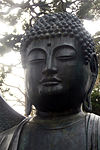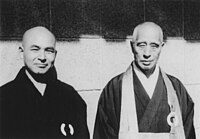

Keidō Fukushima
| |
|---|---|
 | |
| Personal | |
| Born | March 1, 1933 |
| Died | March 1, 2011 (age 78) |
| Religion | Zen Buddhism |
| School | Rinzai |
| Education | Otani University |
| Occupation | Writer Rōshi |
| Senior posting | |
| Based in | Tofuku-ji |
| Part of a series on |
| Western Buddhism |
|---|

Statue of the Buddha in the Japanese Tea Garden, San Francisco
|
|
Main articles
|
|
|
|
|
|
Exchange |
|
General Buddhism
|
|
|
Keidō Fukushima (福島 慶道, Rōmaji: Fukushima Keidō, March 1, 1933 – March 1, 2011) was a Japanese Rinzai Zen master, head abbot of Tōfuku-ji (one of the main branches of the Rinzai sect), centered in Kyoto, Japan. Because of openness to teaching Western students, he had considerable influence on the development of Rinzai Zen practice in the West.

Fukushima became an acolyte monk at the age of thirteen under his original teacher Kidō Okada, abbot of Hōfuku-ji monastery in Okayama, Japan.[1] Fukushima graduated from Otani University's Department of Buddhist Studies in 1956, following completion of Otani's doctoral course. In 1961 he began monastic training with Zenkei ShibayamaatNanzen-ji Monastery in Kyoto.[2] Fukushima's main teacher, Zenkei Shibayama, was instrumental in helping to transplant Rinzai Zen to the West. He was one of the first Rinzai Zen masters to hold retreats in the United States, and to publish books in English: A Flower Does Not Talk, Ox-herding Pictures, and Zen Comments on the Mumonkan / Gateless Barrier. Shibayama made annual visits to the United States in the late 1960s. In 1969 he was accompanied by Fukushima (at that time senior monk at Nanzen-ji and known as Genshō). In 1973 Fukushima received a fellowship to study English at the Claremont Colleges where he conducted seminars on Zen and led zazen practice.[3]
Acknowledged as a Zen master in 1974, Fukushima was appointed vice-resident abbot of Hōfuku-ji where he began to train his own disciples. In 1980, he was appointed master of the Tōfuku-ji training monastery (senmon dōjō 専門道場) in Kyoto.[4] He was elected head abbot (kanchō 管長) of Tōfuku-ji in 1991, supervising 363 affiliated temples.
After being named Zen master and given the name Keidō, Fukushima strove to carry out his teacher Shibayama's intention to introduce Rinzai Zen to the West.[5] He accepted Western students as monks, both at Hōfuku-ji and Tōfuku-ji. Counter to tradition, he let women participate in monastic sesshin-retreats. He conducted annual speaking tours at American universities including Pomona College, Millsaps College, Hendrix College, Bard College, Columbia University, Bucknell University, Xavier University in Cincinnati, Harvard University, the University of Pennsylvania, the University of Kansas, the University of Richmond, Middlebury College and the University of Vermont. From 1991 onwards, these tours included some sesshin-retreats. After decades of contact with American Zen, Fukushima gradually revised his views on it. In October 2007 he wrote:
While American Zen has certainly learned a great deal from Japanese Zen, I think it is now time for American Zen to stand on its own two feet. In contrast with the 'monastic Zen' of Japan, American Zen is essentially a 'lay Zen.'[6]
Fukushima also worked to raise awareness and funds to revive and reconstruct several of China's important historical monasteries, thereby aiding Chán's emergence from the Cultural Revolution's devastating effects.[7] Jōshū's monastery at Zhao Zhou, now known as Bailin, was the first of these efforts to achieve official government support. On later trips, Fukushima and other priests provided assistance for the rebuilding of Manjuji (萬寿寺) on Mt. Kinzan (径山), of particular importance to the Tōfuku-ji tradition since the founder Enni Ben’en (also known as Shōichi Kokushi) trained there between 1235 and 1241.

Well known for his calligraphy,[8] Fukushima was an authority on reading classical Chinese and Kanbun (a hybrid Chinese/Japanese script). Although many Buddhist priests produce religiously inspired art, they rarely create their works in front of an audience. Fukushima realized the very act of doing calligraphy could exert educational and inspirational influence upon those who witnessed it. In keeping with Japanese conventions, he did not give calligraphy demonstrations for Japanese audiences, but he did incorporate such events among his overseas teaching activities.
Around 2000, Fukushima began showing symptoms of the onset of Parkinson's disease, and his health steadily declined. He died on his seventy-eighth birthday (March 1) in 2011.
Throughout his teaching career, Fukushima was clear about what is required to train others using kōan. Guiding others in this training can be done by those who have finished the entire kōan curriculum through rigorous training over many years, then matured further on their own. One can only guide someone else in kōan study when one has gone all the way through it oneself and resolved the One Great Matter.[9]
Fukushima authorized one Japanese Dharma heir, Yūdō Harada (also known as Ji'en; current training master at Tōfuku-ji Monastery),'[10] and one lay successor, Jeff Shore (Fukushima's lay disciple since 1982).[11]
Although Fukushima was strict about preserving the traditional practices of Rinzai Zen, he was open to accepting those of other faiths and traditions as his disciples. Among these were Phra Thana Kaokham (a Thai monk of the Thai Forest Tradition), Muho Noelke (current abbot of the Sōtō Zen temple Antai-ji in Hyōgo, Japan), and Justin Lanier (American Anglican/Episcopal priest). Fukushima permitted Westerners to live in the monastery and train under him at both Hōfuku-ji and Tōfuku-ji. Senior disciples who have done sustained training under Fukushima include Alex Taikei Vesey, Hap Tivey, Tayo Gabler, James Green, Tim Armacost,[12] Ron Sinnige, Alex Buijs, and Sally Stein.
{{citation}}: CS1 maint: multiple names: authors list (link)|
| |||||||||||||||||||||||||
|---|---|---|---|---|---|---|---|---|---|---|---|---|---|---|---|---|---|---|---|---|---|---|---|---|---|
| Main articles |
| ||||||||||||||||||||||||
| Doctrinal background |
| ||||||||||||||||||||||||
| Influential Sutras |
| ||||||||||||||||||||||||
| Teachings |
| ||||||||||||||||||||||||
| Practice |
| ||||||||||||||||||||||||
| Persons |
| ||||||||||||||||||||||||
| Chinese Chán |
| ||||||||||||||||||||||||
| Japanese Zen |
| ||||||||||||||||||||||||
| Korean Seon |
| ||||||||||||||||||||||||
| Vietnamese Thiền |
| ||||||||||||||||||||||||
| USA Zen |
| ||||||||||||||||||||||||
| European Zen |
| ||||||||||||||||||||||||
| Hierarchy and titles |
| ||||||||||||||||||||||||
| Temples |
| ||||||||||||||||||||||||
| Zen literature |
| ||||||||||||||||||||||||
| Cultural influence |
| ||||||||||||||||||||||||
| Related schools |
| ||||||||||||||||||||||||
| Academic research |
| ||||||||||||||||||||||||
| |||||||||||||||||||||||||
| International |
|
|---|---|
| National |
|
| Academics |
|
| Other |
|